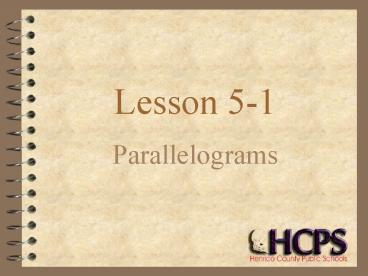Parallelograms - PowerPoint PPT Presentation
1 / 12
Title:
Parallelograms
Description:
Diagonal Property. When the diagonals intersect, they meet at the midpoint of each diagonal. ... 8. If KM = 7, then KP = ____ . 9. If HL = 15, then ML ... – PowerPoint PPT presentation
Number of Views:90
Avg rating:3.0/5.0
Title: Parallelograms
1
Lesson 5-1
- Parallelograms
2
Definition
- The definition of a parallelogram
A quadrilateral whose opposite sides are
parallel. - Its symbol is a small figure
3
Naming a Parallelogram
- A parallelogram is named using all four vertices.
- You can start from any one vertex, but you must
continue in a clockwise or counterclockwise
direction. - For example, this can be either
ABCD or ADCB.
4
Basic Properties
- There are four basic properties of all
parallelograms. - These properties have to do with the angles, the
sides and the diagonals.
5
Opposite Sides
- The opposite sides of every parallelogram are
congruent. - That means that .
- So, if AB 7, then _____ 7?
6
Opposite Angles
- One pair of opposite angles are ltA and ltC. The
other pair is ltB and ltD. - The opposite angles in every parallelogram are
congruent. - Complete If mltA 75? and mltB 105 ?, then
mltC ______ and mltD ______ .
7
Consecutive Angles
- Each angle is consecutive to two other angles.
ltA is consecutive with ltB and ltD. - Each pair of consecutive angles is supplementary.
- Therefore, mltA mltB 180 and mltA mltD 180.
- If mltC 46 ?, then mltB _____?
8
Diagonals
- Diagonals are segments that join non-consecutive
vertices. - For example, in this diagram, the only two
diagonals are .
9
Diagonal Property
- When the diagonals intersect, they meet at the
midpoint of each diagonal. - So, P is the midpoint of .
- Therefore, they bisect each other so
and . - But, the diagonals are not congruent!
10
Parallelogram Summary
- By its definition, opposite sides are parallel.
- Other properties
- Opposite sides are congruent.
- Opposite angles are congruent.
- Consecutive angles are supplementary.
- The diagonals bisect each other.
11
Examples
- 1. Draw HKLP.
- 2. Complete HK _______ and HP
________ . - 3. mltK mlt______ .
- 4. mltL mlt______ 180?.
- 5. If mltP 65?, then mltH ____, mltK
______ and mltL ______ .
12
Examples (contd)
- 6. Draw in the diagonals. They intersect at M.
- 7. Complete If HM 5, then ML ____ .
- 8. If KM 7, then KP ____ .
- 9. If HL 15, then ML ____ .
- 10. If mltHPK 36?, then mltPKL _____ .































